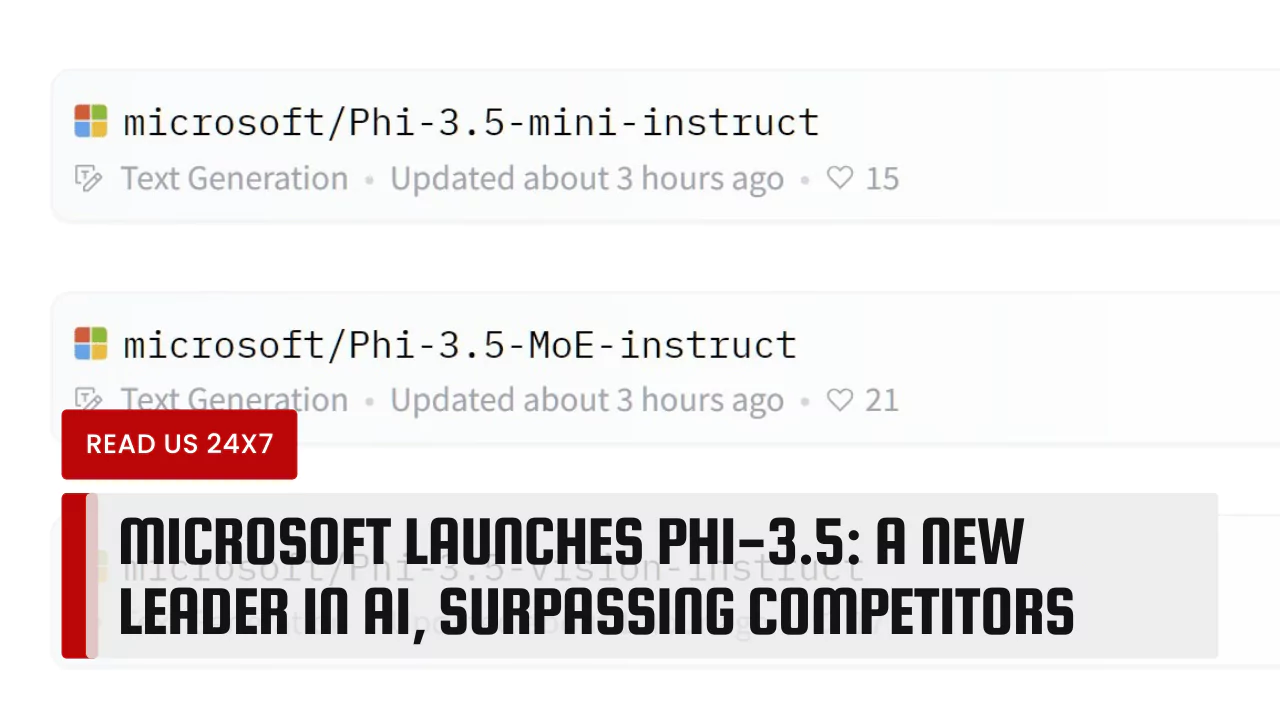Microsoft has released Phi-3.5, a cutting-edge AI model that has a strong reasoning ability. It shows better performance than larger models like Gemini 1.5 and Llama 3.1, only lagging behind GPT-4o-mini. This remarkable advancement highlights Microsoft’s leadership in the AI field.
Three Models for Different Tasks
The Phi-3.5 comes in three different versions: Phi-3.5-MoE-instruct, Phi-3.5-mini-instruct, and Phi-3.5-vision-instruct. Each model has a unique purpose and works well in specific areas.
- Phi-3.5-MoE-instruct features 41.9 billion parameters. It performs advanced reasoning tasks. This model excels in code, mathematics, and logic.
- Phi-3.5-mini-instruct is a smaller model, using 3.82 billion parameters. This model works best for quick reasoning tasks and document summarization.
- Phi-3.5-vision-instruct has 4.15 billion parameters. It analyzes images and videos and excels in visual tasks.
These models allow developers and researchers to choose the right one based on their needs.
Performance Comparison
The Phi-3.5-MoE-instruct model demonstrates significant performance improvements over other AI models. It beats Llama 3.1 with 8 billion parameters and Gemini 2 with 9 billion parameters in various benchmarks.
Phi-3.5-Mini is lighter yet powerful. It competes well against greater models like Llama 3.1 and Mistral 7B. Phi-3.5-vision-instruct even outperforms OpenAI’s GPT-4o in image tasks. This clearly shows how Microsoft’s new models excel in their respective fields.
Unique Features
One standout feature of Phi-3.5 is the ability to understand long contexts. The Phi-3.5-MoE and Phi-3.5-mini have a context length of 128,000 tokens. Most competitors handle only 8,000 tokens. This means Phi-3.5 can keep track of more information at once. It enhances its effectiveness in tasks like information retrieval.
Another critical aspect is the training process. Phi-3.5 was trained over several days using hundreds of powerful GPUs. It analyzed trillions of tokens. This extensive training helps the model to understand complex tasks better and improve accuracy.
Multilingual Capabilities
Phi-3.5 supports multiple languages. This makes it suitable for a global audience. The exact languages supported are not yet known. However, this capability allows diverse users to benefit from the model without language barriers.
Ideal Use Cases
Microsoft designed the Phi-3.5 models for various applications. These include:
- General-purpose AI systems
- Tasks that require advanced reasoning
- Applications in code and mathematics
- Document summarization and retrieval
- Image and video analysis
These use cases highlight the model’s versatility and ability to support different industries.
Open-Source Availability
The Phi-3.5 models are open-source. They are now available on Hugging Face under an MIT license. This allows developers to access the models without restriction. It promotes collaboration within the AI community. Researchers and developers can experiment and improve the models further.
Training Insights
The training of Phi-3.5 models used advanced methods. Using supervised fine-tuning ensured that the model followed instructions properly. Proximal policy optimization helped in refining how the model made decisions. Direct preference optimization improved adherence to user instructions.
Training required significant resources. Phi-3.5-MoE was trained with 512 H100-80G GPUs for 23 days. Phi-3.5-mini was trained using 512 GPUs over 10 days. Finally, Phi-3.5-vision was trained on 256 A100-80G GPUs over six days. This intensive training effort contributes to its robust performance.
Safety Measures
Microsoft incorporated safety features in Phi-3.5. These measures ensure the model acts responsibly. It reduces the chances of generating harmful or biased content. Developers can use the model confidently. They can implement it in scenarios without worrying about unsafe outputs.
Conclusion
Microsoft’s launch of Phi-3.5 marks a significant moment in AI technology. These models stand out due to their performance and features. They surpass competitors in many areas. Phi-3.5 is a flexible solution for tasks ranging from simple queries to complex image analysis. With open-source access, the model invites collaboration and innovation. For anyone in the AI field, Phi-3.5 shows a bright future ahead.



